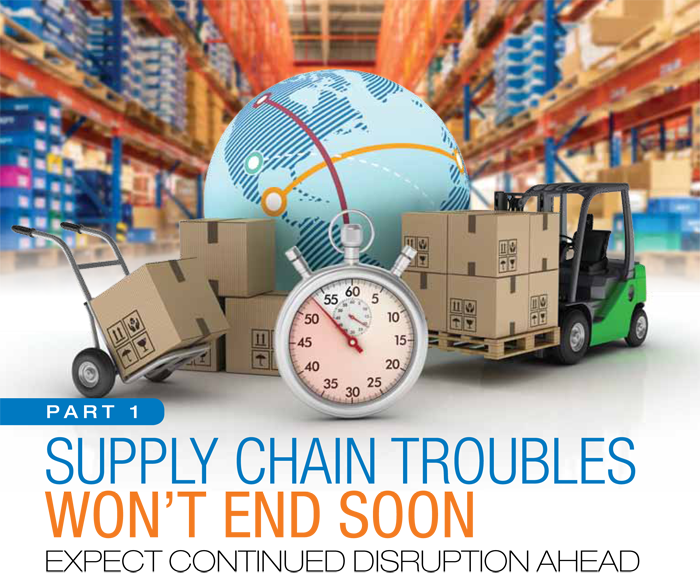Supply chain troubles won't end soon

by Howard Coleman
This two-part article will explore a series of questions. But first an update that will serve to answer the one question I’m most frequently asked: How and when will we come out of the current situation of limited supplies and distribution challenges?
Supply chain snarls are probably here to stay – and for some time. Specific challenges may abate at some point, but new ones will arise. Omicron? Just what we needed, right?
We should recognize that the pandemic-driven turmoil may have put supply chains on the public’s radar, but there have been other major disruptions that were not COVID-related; think trade wars, Brexit, the Texas freeze, Hurricane Ida, etc. What about the cargo ships that got stuck in canals? But the over-riding issue still is; will COVID-19 ever transition from a pandemic to something that is maybe more endemic and flu-like?
There is a sense, also, that supply chain disruptions will continue to happen both more frequently, and with potentially larger magnitude. For companies, these issues have grown from being a responsibility handled by day-to-day operations teams into a CEO-level priority.
So, surely don’t expect much relief before the second quarter. Even then it might mean that we just reach a better understanding of the state of actual demand and further inventory constraints. So clearly, we are not out of the woods yet. But as companies continue to navigate their way through the crisis, they are learning much about the vulnerabilities of their own supply chains. Some are also investing in and refocusing on supply chain technology and improved processes. These investments are likely to bear fruit whenever “normality” returns or when inevitable disruptions and unexpected turmoil hits us next.
If COVID-19 has taught us anything, it’s that supply chains need to change. They worked pretty well until they didn’t. Along came a virus that spread so fast, with such infectious and deadly consequences, that it literally shut down the entire world. Clearly, the supply chain was not up to the task. It also has become increasingly clear that the U.S. needs to produce more goods domestically and/or closer to home in order to protect its economic security.
The labor picture is murky
Job postings (for instance, on Indeed.com) for supply chain and logistics specialists are up over 37 percent since last April. Does this mean that product flow issues have accelerated a skills gap? It seems so. Jobs in demand-planning have transformed into roles that some say require data scientists as opposed to traditional buyers and purchasing agents, positions which historically have been mostly transactional based. Some are suggesting that supply chain managers now need to be data architects.
But, all these corrective actions are not around the corner. As long as demand holds up during the short- to near-term, and during industry-specific seasonal bumps, COVID-19 still lingers, climate change – and more specifically extreme weather – may yet batter the supply chain links. There’s an increased chance for labor strikes, transportation cost increases and, of course, the ever present political tensions with China as well as with other adversaries. Plus, the policy debate internally within the U.S. So expect the disruption to persist for a while with all it entails.
 Did we miss something?
Did we miss something?
Here’s another question I’m often asked: As the pandemic ravaged distribution and the supply chains, what was industry’s blind spot? I don’t think it was so much a matter of blind spots. More simply, it was a confluence of low-probability/high-impact pandemic-related circumstances that quickly became world-wide issues, as opposed to what we’ve become more accustomed to, for instance, a regional supply anomaly, a nuclear reactor meltdown, a tsunami or a hurricane. This time we found ourselves dealing with a once-in-a-lifetime event, although a good question is: Will similar events now be in our future?
Yes, some companies were more flexible and had more mitigation policies in place than others (more on that later), which helped them.
But, now that we have borne the experience, it’s probably time for us to have learned that whether local, regional or on a global scale, we must be prepared for similar uncertainty, more constant change and a higher level of volatility. The world seems to have undergone a fundamental change.
Times of uncertainty, though, also present opportunities to innovate and experiment, even though those innovations and experiments present, on their own, additional changes.
Speaking of blind spots, some main street media journalists have made some good points about the current supply chain crisis, although I sense that few of them really know about supply chain management. They rarely get beyond the basics of describing the symptoms.
But regardless, the commentary has been quite electrifying.
Here are some snippets from various prominent publications:
“A sturdier supply chain will require companies to pivot from the “just-in-time” approach that saved money but left America vulnerable.”
“For years, companies prioritized JIT manufacturing, pioneered by Toyota. That left little excess inventory on hand to cushion disruptions.”
“More companies are expected to re-embrace ‘just-in-case’ – keeping lots of goods and components on hand, as a hedge against
disruption.”
To pin this all on JIT, as some singular failure that caused the whole problem, frankly, is clueless. And it’s resulted in a lot of JIT cherry-picking and finger pointing (blame the port workers or truck drivers). Pointing at Wall Street might be closer to it for fostering and incentivizing off-shore production, the financialization of production, good for stock prices, bad for American industry and its supply chain infrastructure.
The essence of the JIT model was the relationship with its suppliers, preferring suppliers within 200 miles of plants. The JIT model was secure because it was highly localized; any risks of disruption were minimal. Many U.S. companies took a different approach. They also wanted “China/Asian region prices.” So they elongated the supply chain and the lead times. They mostly pressured their suppliers to assume the risk for them and to develop relationships with the supporting Asian suppliers. In effect, another burden (risk) had been outsourced to supplier sources. Along came COVID-19 or, even before, some other unusual circumstances.
But now, some manufacturers and suppliers from a variety of industries have chimed in. They are echoing that “we need to go back to the days of traditionally holding lots of safety stock” based on demand forecasts and lead times (and growing lead times at that). But, it’s just not sustainable.
We’ve found that there are many dimensions to supply chain disruption. Geography, scope, demand vs. supply equations, the supply chain management and planning experience that exists within a company, the term of the emergency (short-term or long-term) and, finally, we have human behavior, with its previously unknown impact. Just think about how people have reacted to this crisis. Totally unexpected, in my view, or was I just being naïve?
Something’s happenin’ here
There is something different going on and it is quite strange. The GDP is growing but we’re also suffering from a dearth of a shocking array of things and it still involves toilet paper.
This everything shortage is not the result of one big bottleneck in, say, an Asian factory, a fire in a U.S Midwest factory, or a problem with the American trucking industry. We are running low on supplies of all kinds due to a pandemic of bottlenecks, complex disruptions of all types with seemingly no end in sight.
What caused the supply chain breakdown?
Another question I’m asked: “When the domestic and international supply chain broke down, what were some of the unique issues?”
The coronavirus pandemic snarled global supply chains in several ways. First, the pandemic checks sent hundreds of billions of dollars to cabin-fevered Americans during very difficult times for many of our citizens. A lot of cash flowed into the system and people bought many of the products imported from or that travel through East Asia. But we shouldn’t lose sight of the fact that Asia also was dealing with COVID-19.
One of the most heavily reported and dramatic expressions of this squeeze, as we’ve all learned, is the loaded containers on ships sitting off the coast of Los Angeles and Long Beach, California. It’s like too many drivers trying to use too few lanes. Add to that the shortage of trucks, truck drivers and port workers. Because ships can’t be unloaded promptly, not enough empty containers become available for a return trip to Asia, so they just end up sitting around, parked at West Coast ports remaining uncollected and idle. In fact, it’s currently estimated at roughly 350,000 containers. Subsequently, inland U.S. exporters can’t get their hands on them. That’s not good for the trade deficit.
We’re short on ships. Sufficient new capacity isn’t expected to be online until sometime in 2023. These new ships are much larger, too, meaning it probably will create potential infrastructure problems at some ports. Remember the ship that blocked the entire width of the Suez Canal for almost a week, delaying nearly $10 billion in cargo per day? But again, all this didn’t stop the New York Times from proclaiming “an excessive reliance on just-in-time manufacturing.” You can see how pervasive this vilification is.
Yes, JIT focuses on minimal inventory, but it is also a provisioning system, too, providing end-users with what is needed, when it is needed. JIT starts with a production process but it ends with the consumer or point of consumption, probably located far from the factory, encompassing the transportation, distribution, and the wholesaling and retailing aspects of the supply chain. So, we rely heavily on transportation and logistics networks to provide us with the things we need in a timely way, both internationally and domestically produced. Ships, trains and trucks have become floating warehouses and warehouses on wheels with long lead times.
What about the truckers? A recent survey indicated that the country has a shortage of about 60,000 drivers, due to ongoing recruitment difficulties and early retirements. COVID-19 even canceled driving-school classes. Then there is the labor market more generally.
Labor shortages existed before COVID-19. Did unemployment insurance and several rounds of stimulus checks exacerbate the situation, allowing workers to be more picky about jobs, instead of jumping at the first available paycheck? I think there is more than meets the eye on that one. And, of course, from the perspective of many employers, these programs made a bad situation even worse.
We now find ourselves also relearning the lessons of Economics 101. High demand, plus limited supply, equals spiraling prices.
Looking ahead
Yes, this has sparked deeper questions about whether any industry’s strategies to prioritize efficiency and maintain reasonable inventory will endure in the post-pandemic world. The concentrated approach to having vendors nearby, meaning within and/or adjacent countries – particularly overseas – worked. Until it didn’t due to pandemic lockdowns and restrictions. The same can be said pretty much domestically.
So the question regarding supply chain disruption remains: Will it spark a long-term shift? Somehow it all seems dependent, I believe, on the current COVID-19 pathway and the belief that there will be other similar threats in the future. It may – or may not – make sense to uproot supply chains. Somehow, though, I doubt that the majority of manufacturers and suppliers will throw out the baby with the bath water and nullify all they have done in the past, although it’s been often predicted over the past 35 years. In fact, this questioning has happened frequently, whenever a crisis arises, whether it was that nuclear reactor meltdown or tsunamis, or again, a fire in a Midwest factory.
Rather, why don’t we look at ways to better allocate production and distribution and diversify the risks? Maybe even dip into profits to invest in rainy day resilience.
Finally, how is this all resolved? It’s been suggested that the best solution is to have a policy to make more. For instance, containers, which carry more than 90 percent of the world’s trade, are overwhelmingly made in China. Why don’t we make more? Car parts, semiconductors and many other goods have been offshored, making us reliant on overseas factories. Why can’t we make more? Why can’t we make more of, well, everything? At the very least, we’d be diversifying our supply chains.
Next issue, we’ll answer some additional questions and suggest some action steps that could have helped us avoid (in hindsight) the issues that we faced, as well as potentially limiting future supply chain hardships.
 Howard W. Coleman, principal at MCA Associates, a management consulting firm, works with wholesale distribution and manufacturing companies seeking and committed to operational excellence, implementing continuous improvement solutions and much more. Howard is also the creator of the “MCA Talk” Podcast Series: Distribution on the Cusp of Metamorphosis. Contact him at (203) 906-7268 or by email at hcoleman@mcaassociates.com.
Howard W. Coleman, principal at MCA Associates, a management consulting firm, works with wholesale distribution and manufacturing companies seeking and committed to operational excellence, implementing continuous improvement solutions and much more. Howard is also the creator of the “MCA Talk” Podcast Series: Distribution on the Cusp of Metamorphosis. Contact him at (203) 906-7268 or by email at hcoleman@mcaassociates.com.
This article originally appeared in the March/April 2022 issue of Industrial Supply magazine. Copyright 2022, Direct Business Media.













